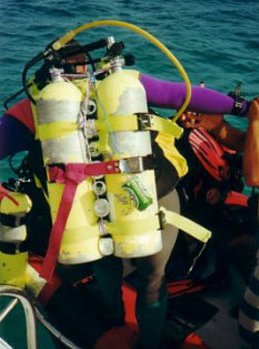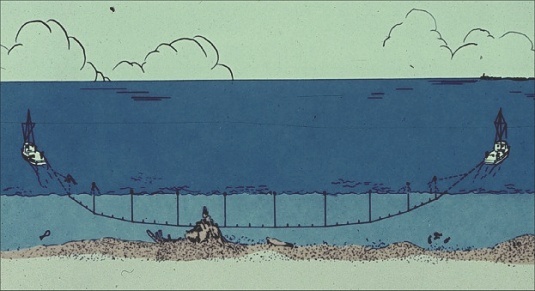Air Fills
The proper way to fill a scuba cylinder is very slowly so that the heat generated by the filling process can be bled away as it happens, and the tank does not become overheated. That's a great theory, but in real life, nobody does it that way. Most tanks are "hot-filled", that is to say, that they are filled too fast to prevent them from heating up during the process. If they are filled directly off a compressor, then they will receive a very hot fill. You would be surprised how warm the surface of a tank can get. This is not much of a safety issue, though, as it is well within the thermal limits of the material, either aluminum or steel.
The real issue here is that eventually ( after a few hours ) the tank will cool down, and as it does, the air inside will contract, and the pressure will drop. This typically results in about a 10% loss of pressure. At this point, you could top it off to the rated pressure again and have a truly full tank. Most of the time that's not an option. Therefore, if the shop hot-fills your tank to 3000, you will end up with 2700. To get 3000, you need to fill the tank to about 3300. While this is verboten, it is well within the 5/3 overpressure of the hydro test, and realistically there is no danger. The slight overpressure may wear out your o-rings a little faster, but o-rings are cheap - get a dozen of them at the hardware store for a buck.
Some shops will refuse to do such hot-overfills, after all, they're not supposed to. If you are willing to leave your tanks and pick them up another day, you can get a top-off and walk out with a good fill. If that is not possible or practical, and your shop will not give you a good fill that will cool down to 3000 ( or whatever ) - then find another shop that will.
Another issue with air fills is the quality of the air you are getting. What you want is pure, clean, dry air. What you may get is water, compressor oil, carbon monoxide, pollen, and other contaminants. This depends on the setup of the facility and the quality and maintenance of the compressor and filters. Air intakes should be away from sources of chemical contamination such as parking lots. Filters should be changed regularly, and the compressor itself should be modern and well-maintained. Ask around and verify the shop's reputation with regard to their air quality. Most are good.
Here is the actual Federal regulation regarding pressure rating of gas cylinders, courtesy of Kenneth Adelman:
[Code of Federal Regulations]
[Title 49, Volume 2]
[Revised as of October 1, 2006]
From the U.S. Government Printing Office via GPO Access
[CITE: 49CFR173.301a
[Page 599
TITLE 49 -- TRANSPORTATION
CHAPTER I -- PIPELINE AND HAZARDOUS MATERIALS SAFETY ADMINISTRATION, DEPARTMENT OF TRANSPORTATION
PART 173 SHIPPERS GENERAL REQUIREMENTS FOR SHIPMENTS AND PACKAGINGS -- Subpart G_Gases; Preparation and Packaging
Sec. 173.301a Additional general requirements for shipment of specification cylinders.
(a) General. The requirements in this section are in addition to the requirements in Sec. 173.301 and apply to the shipment of gases in specification cylinders.
(b) Authorized cylinders not marked with a service pressure. For authorized cylinders not marked with a service pressure, the service pressure is designated as follows:
| Service Specification Marking | Pressure (psig) |
| 3 | 1800 |
| 3E | 1800 |
| 8 | 250 |
(c) Cylinder pressure at 21°C (70°F). The pressure in a cylinder at 21°C (70°F) may not exceed the service pressure for which the cylinder is marked or designated, except as provided in Sec. 173.302a(b). For certain liquefied gases, the pressure at 21°C (70°F) must be lower than the marked service pressure to avoid having a pressure at a temperature of 55°C (131°F) that is greater than permitted.
(d) Cylinder pressure at 55°C (131°F). The pressure in a cylinder at 55°C (131°F) may not exceed 5/4 times the service pressure, except:
(1) For a cylinder filled with acetylene, liquefied nitrous oxide, or carbon dioxide.
(2) For a cylinder filled in accordance with Sec. 173.302a(b), the pressure in the cylinder at 55°C (131°F) may not exceed 5/4 times the filling pressure.
(3) The pressure at 55°C (131°F) of Hazard Zone A and, after December 31, 2003, Hazard Zone B materials, may not exceed the service pressure of the cylinder. Sufficient outage must be provided so that the cylinder will not be liquid full at 55°C (131°F).
(e) Grandfather clause. A cylinder in domestic use prior to the date on which the specification for the cylinder was first made effective may be used if the cylinder has been properly tested and otherwise conforms to the requirements applicable to the gas with which it is charged.
[67 FR 51645, Aug. 8, 2002, as amended at 67 FR 61289, Sept. 30, 2002; 68 FR 24661, May 8, 2003]
In summary, a tank may be legally overfilled to up to 5/4 its rated pressure provided the temperature does not exceed 131°F, and the final cooled-down pressure at 70°F is at or below the rated pressure.


